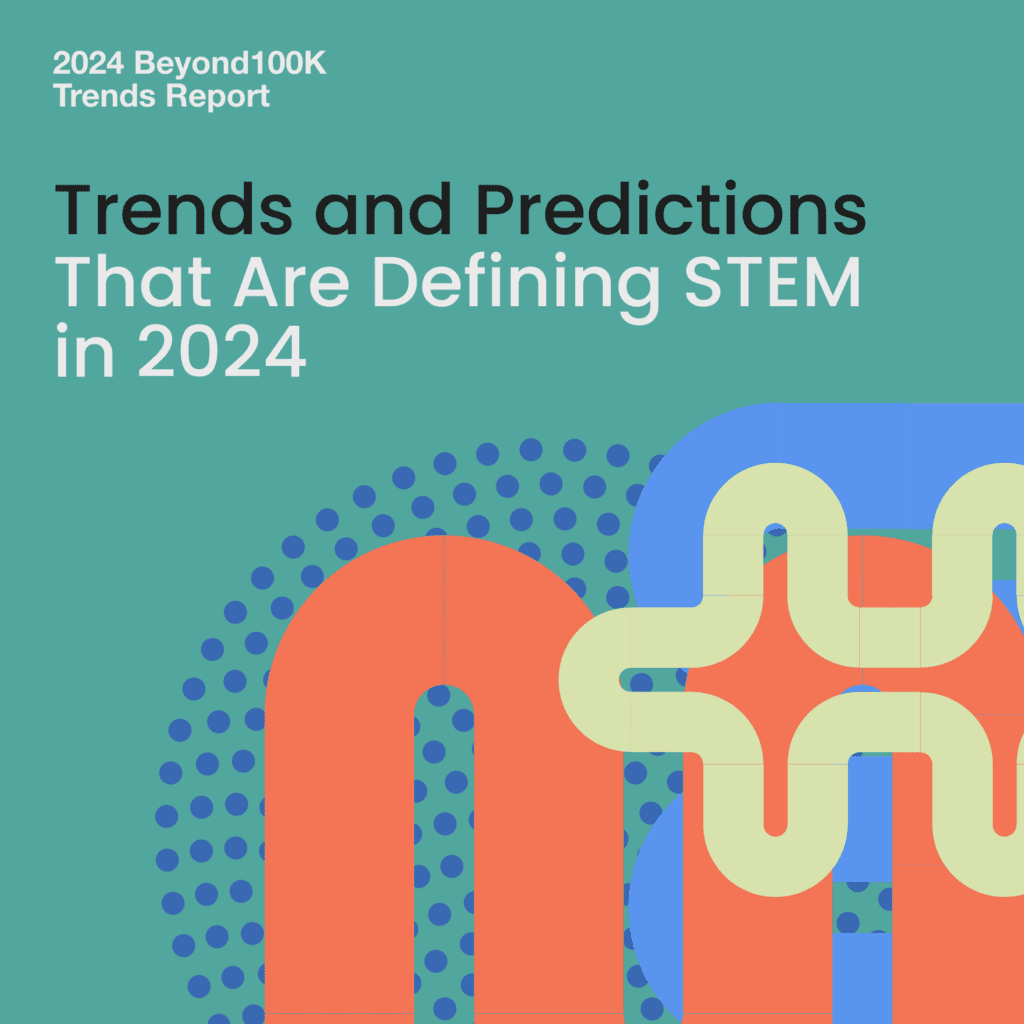In the ever-evolving landscape of STEM education, the challenges faced by educators are multifaceted, demanding a nuanced understanding and collaborative solutions. Drawn from extensive research and conversations with countless stakeholders in the Beyond100K network and the broader STEM ecosystem, this year’s Trends Report delves into four significant trends shaping the future of education and offers field-leading insights and solutions to share with you.
Since the onset of 2020, a perpetual state of change and uncertainty, aptly termed “perma-crisis,” has become an unwelcome constant in our lives. Collins Dictionary named this term a 2022 word of the year, reflecting the enduring challenges posed by the global pandemic, climate change, geopolitical conflicts, and political upheavals.
Professor Danny Ralph of Cambridge’s Centre for Risk Studies notes that while crises like famines, wars, and pestilence have always existed, they seem to be occurring at an accelerated rate. This acceleration challenges our ideas of returning to a pre-existing state of “normal” and requires adapting to the constant flux.
Amidst the perma-crisis, we’re noticing a shift from a focus on flexibility to an urgent search for certainty. We engaged hundreds of people to identify the challenges that persist in STEM education, and from their responses, we distilled thousands of data points. A common thread emerged: Across different arenas and areas of education, the quest for clarity is top of mind.
Research indicates that uncertainty activates pain centers in the brain akin to physical pain, impacting our capacity to focus, collaborate, and solve problems. In response, we’re seeing STEM education leaders wrestling with questions about the definitions and parameters within the education landscape. People are seeking clarity on things as foundational as the very definition of STEM and belonging, and they are also yearning for predictability in a topsy-turvy world.
Despite the challenges that constant change creates, we’re seeing Beyond100K partners leading efforts to create clarity and responsive frameworks for future direction.
The Beyond100K Equity in High School STEM Moonshot CoLaboratory, one of seven last year, sought to answer the seemingly simple question: How might we better understand the needs of historically marginalized students in different communities? Over 6 months, they collaborated and created student-centered interview protocols and surveys that could be used in a variety of settings to help stakeholders uncover the unique challenges faced by students in their communities.
Additionally, the Beyond100K Supporting STEM Education in Tribal Communities Project Team published “First Steps: A Resource for Engaging with Indigenous Communities in STEM” in collaboration with the US Department of Energy, providing a contesting and guiding questions to navigate STEM Education in Tribal settings for non-Native STEM Educators who would like to begin outreach and engagement with Indigenous communities. In the pursuit of greater stability, Beyond100K partners are leading the way, creating tangible resources and protocols to navigate the complex landscape of education.
As our nation grapples with ongoing uncertainty, schools find themselves at a crossroads – tasked with reshaping classrooms to foster inclusivity and joy, developing career-relevant curricula, and integrating emerging technology. All the while, educators face heightened scrutiny due to residual pandemic learning loss and ongoing declines in standardized test scores in math and literacy.
Over the last couple of years, we saw a groundswell of momentum around fostering classrooms of belonging, delivering rigorous and relevant content, and enhancing socio-emotional learning (SEL). Now, we’re seeing movement in a different direction. Recent drops in math and literacy standardized test scores, coupled with challenges to SEL and culturally relevant curriculum, have introduced new tensions for educators. We’re noticing a growing movement, highlighting the delicate balance between our need to adapt to a dynamic world and our reliance on standardized metrics to gauge progress.
Mandates are racing to keep pace with change, while simultaneously acting as a brake on progress. Research demonstrates a positive correlation between a sense of belonging in STEM classrooms and academic performance, retention, and persistence, particularly for Black, Latinx, and Native American students. Similarly, students engaged in SEL programs show improvements in academic performance and social well-being.
Teachers find themselves under renewed pressure to elevate test scores and address learning loss, and additionally, new laws are being passed, restricting the scope of what can be taught, and limiting discussions on equity, diverse literature, and socio-emotional concepts, among other subjects. Educators we interviewed expressed concerns about the fear of repercussions for addressing bias and inequity in their teaching and the difficulty of incorporating this work amid the pressures to focus on raising test scores.
As one focus group participant noted, “One of the challenges spoke to teachers being scared to talk about the right thing, doing their own self-work to be able to talk about culture relative to their work. Regulations in states prevent teachers from having these conversations.”
Despite these challenges, we see an emerging trend: that education leaders view joy, belonging, and relevance not in conflict with academic testing, but as the pathway by which student academic success can be achieved. Evidence supports the idea that joy-based learning leads to better academic outcomes, particularly for students of color.
Exemplifying this philosophy, the Beyond100K Foundational Math CoLaboratory, comprised of partners from across the STEM learning ecosystem, has developed a repository of joyful mathematical resources and activities for educators and families to use in making math joyful for their students.
Our partner, Community Resources for Science, employs a student-belonging-centered science teaching approach in their Bay Area Scientists Inspiring Students (BASIS) program, where scientist and engineer role models bring real-world connections, diversity, and inquiry-based learning into school environments. Teachers observed that students who engaged with these career scientists were participating or demonstrating skills above their typical classroom level.
It would be impossible to talk about current trends in STEM education without addressing the teacher shortage. The sheer magnitude of the shortage, coupled with the constant chatter in media and on social platforms about vacant classrooms and the repercussions of the shortage on the educational well-being of today’s students, may have finally spurred discussions on teacher pay. In 2023, we saw a surge in movement nationwide around the critical issue of teacher pay. New salary increases already passed in 31 states and the District of Columbia, and in 2023 alone, 26 states introduced bills to raise teacher pay, marking a shift that we hope will continue to be a pivotal focus in 2024.
Despite this optimistic trend, the persistence of low teacher pay remains a surprising and perplexing reality. The laws of economics would suggest that a chronic shortage in an essential sector should naturally lead to increased pay. However, teachers still earn 24 percent less than comparable college graduates, with far-reaching consequences.
Our conversations with hundreds of STEM education leaders and our analysis of thousands of data points highlight that insufficient compensation remains a top hurdle in overcoming the teacher shortage. Additionally, according to the National Survey by the National Center for Education Statistics, 86 percent of public schools reported challenges hiring teachers for the 2023 – 2024 school year. Even with the high demand for teachers, their salaries have barely risen since the 1990s. Adjusted for inflation, teacher pay increased by just $83 from 1989 to 2021, in comparison to an increase of $445 in other professions requiring a college degree.
We’re seeing innovative ways to address teacher pay where increasing salaries hasn’t yet been achieved. The National Education Association (NEA) urged the Department of Labor to reconsider labor laws preventing teachers from qualifying for overtime pay. Some districts are considering creative strategies such as reallocating budgets from benefits to salaries. Connecticut has taken on a proactive approach, implementing a number of incentives to help keep and attract teachers, including a mortgage assistance program, loan forgiveness and deferral, and different forms of financial aid.
We predict continued movement toward improving teacher salaries in 2024, but we also hope for a broader conversation that delves into the deeper foundational issues. Beyond the technocratic problem of finding the money, what is it about our perception that it has taken us getting to this point before seeing momentum in compensation?
Professions that are traditionally seen as women’s work continue to face lower pay and longer hours. Given that teaching is undoubtedly among the professions most associated with women in our current workforce, might this be playing a role? In the coming year, we hope for an expanded conversation around pay equity and the sustainability of a profession that plays a pivotal role in shaping the future of our society. The journey toward fair compensation is a nuanced one, requiring a collective effort to redefine the value we place on educators.
Although teacher pay is a significant challenge impacting the STEM teacher shortage, we’re also seeing rising attention to the need to reimagine the structure of the teaching profession to reflect the desire for flexibility in today’s workforce.
In an era where remote and hybrid work has become the norm for various industries, the absence of flexible time remains a constant for many teachers. A rising number of workers across the nation have expressed a willingness to take a pay cut for the opportunity to work remotely, a luxury seldom available to teachers, particularly amidst ongoing concerns about the long-term effects of remote learning.
Teachers find themselves tethered to their classrooms, finding it challenging to take leave for illness, professional development, or childcare, ultimately impacting their decisions to remain in the profession. In our research, we found that lack of flexibility during the workday for professional development is one of the keystone challenges impacting teacher retention.
One impediment to flexibility: access to competent substitutes who can step in to give teachers the space and time to leave their classrooms when they need to, whether for professional development or to care for a sick child (or themselves). As one educator told us, “Teachers need capable and competent substitutes to facilitate learning from each other, especially when educators already have too much on their plates.” In response to this challenge, we’re seeing rising discussion on how substitute teachers could infuse greater flexibility into the teaching profession and bolster the pipeline for potential educators.
Currently, districts are still struggling to find enough substitute teachers, especially given the rise in teacher absences since before the pandemic. Some mirror the rise in teacher pay, offering increased compensation and bonuses to substitutes. Others are pioneering “grow your own” pools of substitute teachers, providing substitutes with quality preparation through partnerships with colleges of education and residency programs, allowing them the option to become full-time, certified teachers. Since many current substitute teachers express a desire for a full-time teaching role, these temporary positions can serve as stepping stones into permanent careers. Some districts are actively considering and developing pathways to transition substitute teachers into full-time roles, recognizing the potential of a pool already engaged in the school community.
As the education landscape evolves, the spotlight on flexibility as a key factor in teacher retention and recruitment is gaining momentum. While challenges persist, it’s clear there is an interest in considering pathways to a more flexible future for educators.
In the face of these trends, we believe that the collaborative efforts of Beyond100K partners will be instrumental in driving positive change throughout the STEM education landscape in the upcoming year. As we navigate uncertainty together, these insights illuminate pathways to progress. The commitment of Beyond100K partners signals a shared dedication to overcoming obstacles and creating impactful solutions. Together, we are poised to make significant strides and shape the trajectory of STEM education in 2024.



